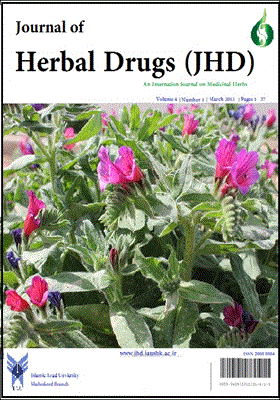Effect of Gibberllic acid and Salicylic acid on Secondary metabolites in leaf of Curcuma longa L.
الموضوعات : مجله گیاهان داروییمریم وکیل زاده انارکی 1 , فروغ مرتضایی نژاد 2 , فریبا خلیلی 3 , محمد مهدی قیصری 4 , مهتاب اصفهانی زاده حسین پور 5
1 - گروه علوم باغبانی، دانشگاه آزاد اسلامی، واحد خوراسگان (اصفهان)، اصفهان، ایران؛
2 - گروه علوم باغبانی، دانشگاه آزاد اسلامی، واحد خوراسگان (اصفهان)، اصفهان، ایران؛
3 - گروه علوم باغبانی، دانشگاه آزاد اسلامی، واحد خوراسگان (اصفهان)، اصفهان، ایران؛
4 - گروه شیمی، دانشگاه آزاد اسلامی، واحد خوراسگان (اصفهان)، اصفهان، ایران؛
5 - گروه علوم باغبانی، دانشگاه آزاد اسلامی، واحد خوراسگان (اصفهان)، اصفهان، ایران؛
باشگاه پژوهشگران جوان، اصفهان، ایران؛
الکلمات المفتاحية: Salicylic acid, Gibberellic acid, GC/MS, Turmeric, Secondary metabolites,
ملخص المقالة :
Background & Aim: Turmeric, scientifically named (Curcuma longa L.), a member of ginger (Zingiberaceae) family, is a perennial plant, with pharmaceutical properties and with a rhizome. This plant has many medicinal characteristics including anti-cancer, anti-bacteria and anti-hepatitis properties. Experimental: To study the effects of Gibberellic acid and Salicylic acid on leaf, the rhizome was obtained from Thailand and was cultured for two years in the greenhouses of Khorasgan University (Isfahan). Before culture, the rhizome was soaking in 150 ppm of Gibberellic acid for four hour and 400 ppm of Salicylic acid for one hour. The rhizomes were then planted in three blocks in the model of randomized complete blocks. The extract was taken by soxhlet afterwards. Detection of the substances was done by GC/MS. Results & Discussion: Metabolic analysis on the plant showed that most of the metabolites on the leaf include Camphor, pinene, beta- Ocimene and 1,8 Cineole. Consequence of using Gibberllic acid is increasing the amount of Camphor, 1,8 Cineole, Camphene, α-pinene and new terpen components such as Vitamin E, α-Thujone and Limonene in leaves of this plant, also amount of some metabolites such as Camphor, 1,8 Cineole, Camphene increased by using of salicylic acid. Recommended applications/industries: Considering the medicinal specifications of curcuma,in metabolic productionthe amount of some secnedary metabolits can be increased by Growth regulators. because of having some important metabolites curcuma is one of the most important medicinal plants in our traditional and modern medicin.increasing in amount of seconedary metabolites is the result of using Gibbrllic acid and salicylic acid that can make a variety in both number and amount of metabolites.
Abdul Jaleel, c., Gopi, R., Manivannan, P., Sankar, B., Kishorekumar, A., Panneerselvam, R. 2007. Antioxidant potentials and ajmalicine accumulation in Catharanthus roseus after treatment with gibberellic acid. Colloids Surf B Biointerf., 60: 195-200.
Arteca, R.N. 1996. Plant Growth Subestances principles and applications. Chapman & Hall., 300 Pages.
Asghari, G., Mostajeran, A., Shebli, M. 2009. Curcuminoid and essential oil components of turmeric at different stages of growth cultivated in Iran. Research in pharmaceutical Sciences., 4(1): 55-61.
Asrar, Z. 2012. Terpenoids and gibberellic acids interaction in plants. Advances in selected plant physiology aspects., 16: 345-364.
Ferreira, L.A.F. Henriques, O.B., Andreoni, A.A.S., Vital, G.R.F., Campos, M.M.C., Habermehl, G.G., Moraes, V.L.G. 1992. Antivenomand biological effects of ar-turmerone isolated from Curcumalonga (Zingiberaceae). Toxicon., 30: 1211–1218.
Gallego-GiraldoaL, Escamilla-Trevinob, L., Jacksona, L.A., Dixonb, L.A. 2011. Salicylic acid mediates the reduced growth of lignin down-regulated plants. A Plant Biology Division.
Ghasemzadh, A., Jaafar, H.Z.E. 2012. Effect of salicylic acid application on biochemical changes in ginger (Zingiber officinale Roscone). Journal of Medicinal Plant Research., 6(5): 790- 795.
Hatcher, H., Planalp, R., Cho, J., Torti, F.M., Torti, S.V. 2008. Curcumin: From ancient medicine to current clinical trials. Cellular and Molecular Life Sciences.
Irson, R., Jones, D.J.L., Orr, S., Coughtrie, M.W.H., Boocock, D.J., Williams, M.L., Farmer, P.B., Steward, W.P., Gescher, A.J. 2002. Mwtabolism of the Cancer Chemopreventive agent Curcumin in Human and Rat intestine. Cancer Epidemiology, Biomarkers & Prevention., 11: 105-111.
Prinitha, M.H.P., Madoen, J.S.S., Jacod, A. 2012. Phytochemical characterization and antimicrobial activity of oil and solvent extracts of curcuma longa. Research Jornal of Pharmaceutical, Biological and Chemical Sciences., 3: 49- 59.
Majd, A., Madah, M., Falahian, F., Sabaqpor, H., Chalbian, F. 1385. Comparison of salicylic acid on yield, yield components and two susceptible and resistant chickpea resistance to the fungus Ascochyta rabiei. Journal of Biology., 19(3): 314-324.
Mirazadi, Z., Pilevar, B., Meshkat, M.H., Karamian, R.1390. Description of site conditions and to identify the chemical composition of the essential oil Myrtus communis (case Cham sites in the Lorestan). Agricultural biotechnology., (2): 71-79.
Mirheidar, H. 1373. Plant Sciences. Volume 2, the Bureau of Culture, 656 Pages.
Mortazaeinezhad, F. 1383. Morphology and classification of plant. khorasgan (Isfahan) Branch, Islamic Azad University. 308 Pages.
Radhakrishnan, N., Balasubramanian, R. 2009. Salicylic acid induced defence responses in Curcuma longa(L.) against Pythium aphannidermatum infection. Crop Protection., 28: 974-979.
Sticher, L. 1997. Systemic acquiredresistance. Annu. Rev. Plant Pathol. 35, 235–270.
Teixeira da Silva, J.A. 2004. Mining the essential oils of the Anthemideae. African Journal of Biotechnology., 3 (12): 706-720.
Usman, L.A., Hamid, A.A., George, O. C., Ameen, O.M., Muhammad, N.O., Zubair, M.F., Lawal, A. 2009. Chemical composition of rhizome essential oil of curcuma longa L. Growing in north central Nigeria. World Jurnal of Chemistry., 4(2): 178-181.
Xiaoqiang, M., Gang, D.R. 2009. Metabolic profiling of Turmeric (Curcuma longa) plants derived in vitro micropropagation and conventional greenhouse cultivation. Journal of Agricultural and Food Chemistry.


